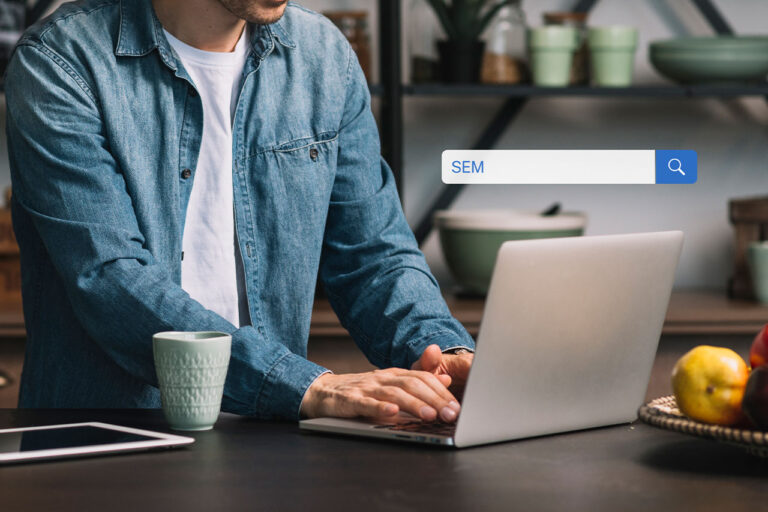Having an optimal structure of a web page is very important for its design and subsequent conversion, as it will help us achieve the goals we want to achieve with the web.
But no, if all the pages in this world are the same and are not designed so that the user has a good experience, how do we expect our website to be a competitive advantage in our business?
Table of Contents
General Structure of a Web Page Start or HomePage
You already know that the home page is the most important and the first the user will see when performing a direct search.
On this page, what we must show at a glance is going to be our value proposition, where we explain what we do and convey why they should hire us in a single sentence so that they either hire us or enter the funnel that we have created with our CTA or call to action.
Since I don’t want to tell you too much, I prefer that you see the example of the structure design in the wireframe that I created. It could vary depending on the type of website and business. In this case, I have focused on a personal brand homepage.
The items you must have are:
- Logo and menu.
- Image of product, company, or personal photography.
- Headings (H1, H2, H3…).
- Call to action buttons.
- Text that helps the user understand our project, etc.
Structure of a Service Landing
Continuing with the example of personal branding, I am going to show you the structure of a services page (which could also be used for a company).
As I am going to repeat to you throughout the entire article, this is an example of the structure of a web page that I have invented in my head, but each website is a world, so they will all be different.
The basic items you should have are:
- Photograph of the person or a company logo design.
- Benefits provided by our service or product.
- Visual content that makes us see what we are selling.
- Testimonials or success stories.
- Calls to action or buttons.
- Frequent questions, etc.
Structure of a Recruitment or Squeeze Page Landing
A squeeze page is a page where it is intended to capture an email to carry out email marketing actions, so we must draw the user’s attention so that they feel the need to leave their email and receive what we are giving away or promoting.
We must make it tempting and have a good strategy behind it to retain the subscriber so that they do not unsubscribe as soon as they receive the first email.
The elements that this recruitment page will contain are:
- Striking title appealing to the advantage.
- Call to action, form, or button.
- Benefits of leaving the email or obtaining the product, info-product, or gift that we are offering you.
- Testimonials or success stories.
- Form or button for whoever has scrolled on the page.
It should be noted that this page could also be only with the first section in which we capture the email. It does not necessarily have to be that long. This will depend on the needs of each squeeze page.
Structure of A Web Page With an Offer
Instead of focusing on a typical product offer that we see in e-commerce in which we simply put an “Offer” sign, I wanted to focus on an OTO ( One Time Offer ), in which something unique is offered for a limited time.
An OTO will be a special offer that cannot be purchased later, so the “now or never” is transmitted.
We can make this offer in the cart through a box with the complementary offer (bump offer), but I have made it in case it is necessary to make an exclusive page for the offer.
The ideal thing about this page is that, if they have already bought a product, they do not have to fill in their purchase data again, but rather they are directly added to what they have already bought. It is an incredible way to increase the shopping cart without investing much effort.
This page will need:
- Timer indicating when the offer ends.
- A very attractive and tempting title (with purchase ultimatum) that invites you to add the product.
- A video or image (better video) of what we are selling.
- Button to add to cart or shopping basket.
Structure of a Product Page [E-commerce]
In e-commerce, the product page is one of the most important parts of the purchase process because if a user reaches our product through good SEO positioning, and the page they land on is horrible, they will leave.
There are many ways to design this page, and depending on the elements and type of product, it will be done in one way or another, but I have focused on the basic one we would have in WordPress.
The basic elements that you should include are these:
- Photographs or images of the product.
- Title, a short description, and a long description.
- Ratings and testimonials to give credibility.
- Anxiety reducers such as “free shipping,” “secure payment,” “guaranteed quality,” etc.
- A video would be an extra plus to add to the page to give more confidence in purchasing the product.
- Use cross-selling and up-selling techniques or cross-selling with related products.
- A footer with the addresses of the company, social networks, and a brief description to give credibility to the web.
Structure of a Blog Page
A blog is a great way to sell ourselves or our products by showing our knowledge or experience in the sector, but we can also play with the elements around the content to further monetize the project.
Therefore, I consider the following elements essential:
- Visual content for the article (all text is boring).
- Content of value of the article itself.
- Persuasive banners about what we sell.
- Lead magnet or content upgrade to engage readers.
- Related articles to increase the time spent on our website and reduce the bounce rate.
- Comments for social interaction.
Structure of a Thank You Page
The thank you page is the one that comes after the purchase of a product or service and can be used to build relationships.
We can do it in different ways, but I especially like this Wireframe example because of the way it retains the user with a video (something very beneficial for SEO) and because we can persuade as we want within it.
In addition to thanking and being “nice,” we can continue selling related products through cross-selling techniques and even make them an OTO (One Time Offer ).
The elements that we should include on this page are:
- Brand image, recognition, and memory of having made the purchase.
- A thank you video (if possible) or a nice image to leave a good memory.
- A section selling another or other related items.
Is It Important To Take Into Account The Parts of My Website?
If, after all, that I just released you, you are still not clear that you have to design the website with a strategy and with structures that convert the objective, I recommend you reread everything and reconsider the opportunities that you are currently losing with your website.
It is essential to create the structure of a web page that allows the user to be guided toward the objective that we have set for ourselves in our business.
For all this, having a good user experience (UX) on our website and a correct design or user interface (UI) will help us earn more money with our project.






















+ There are no comments
Add yours